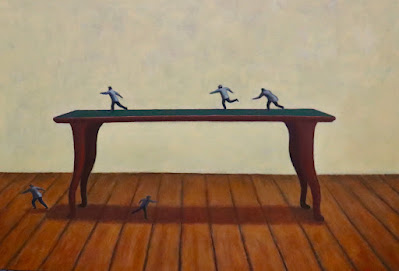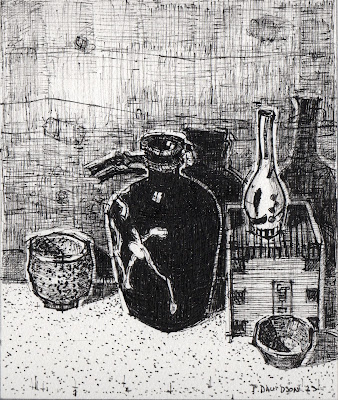The Sidelined Motif
by
Peter Davidson
The print in the second-hand shop
Kyosai rakuga 暁斎楽画 (Kyosai's Drawings for Pleasure)
(Kyosai's Drawings for Pleasure)
https://www.britishmuseum.org/collection/object/A_1915-0823-0-175-2
During my forty years of painting there appears to have been some obvious sidelining of particular subject matter within painting and drawing (still life, household pets, flora and fauna in their natural states [meaning how they’re seen in the poetry of light /the colour of time] etc…,), it is as though such motifs have been regulated to a lesser genre within the contemporary arts and its associated museums/state galleries, and yet these afore mentioned painterly motifs historically as well as in a modern sense maintain a huge prominence within our quotidian lives.
Why dogs, cats, family portraits, garden flowers along with shrubberies that adorns one’s abode, utensils such as tea cups, pots, plates, table clothes and other ceramic wares (see link below to view Kathleen O’Conner’s Tea Time painting) now so absent from contemporary visual memory, but remain part of daily conversations and often remarked upon in everyday coffee chitchat is unusual. But was it always this way?
Some of the old sake cups and bottles collected from the second hand store Ive drawn.
Pen and ink and charcoal on 300 g paper
20.5 cm h x 17 cm w
For example, in the heavy/light industrial, fishing ports of Kobe, I often go around second-hand shops searching for unassuming old sake bottles/cups to paint and draw not only because there cheap and interesting subject matter but tend to be passionately made and seemingly imbued with all the memories humanity can muster in household, tavern and restaurant conversations whilst give me great pleasure in touching such objects, whilst looking into them with an intense gaze that might unravel something unseen through forensic rhopography (looking at the over looked) and that kind of observation for an artist is not new.
Recently when searching for old sake cups, I came across this antiquated ukiyo-e print (top) within an out-dated frame on the shop's wall, its motif was of three rabbits, immaculately drawn/printed with great sensibility. Every time I went back to that second hand shop, this drawing nagged me because it was so good. I looked at it for several months then finally bought it.
The rabbits seemed as alive today in a modern sense as they were when drawn in the Meiji period and printed. My research revealed that the artist of the Rabbits woodblock print was Kawanabe Kyōsai and as the art historian, wrote Timothy Clarke,
"an individualist and an independent, perhaps the last virtuoso in traditional Japanese painting".
https://en.wikipedia.org/wiki/Kawanabe_Ky%C5%8Dsai
Timothy Clark, Demon of painting: the art of Kawanabe Kyōsai, London: Published for the Trustees of the British Museum by the British Museum Press, 1993 page 16
Kyōsai is outstanding with a drawing sensibility that rivals any other greats of the art, his subject matter is often of the simple community and belonging to the household that happen in our daily lives. But Kyōsai isn’t the only one who used everyday motifs. The French painter Paul Cezanne used a common table fruit being an apple to bring change to painting as he stated here;
‘With an apple, I will astonish Paris’
https://www.tate.org.uk/tate-etc/issue-56-autumn-2022/the-apple-of-my-eye
And so Cezanne did his paintings march on into history and the humble table apple that caused so much change in painting has almost disappeared from museums and galleries along with many other motifs. It appears the very unassuming quotidian motifs have bought about the most facinating shifts in painting I hope it continues.
Kathleen O’conner Tea Time Painting - Art Gallery of Western Australia
https://collection.artgallery.wa.gov.au/objects/849/lheure-du-the-tea-time









.JPG)
